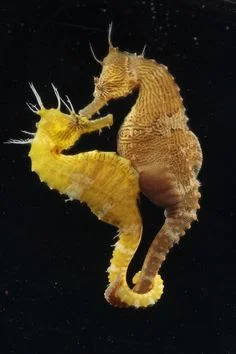Seahourse
Hi friend's...

The seahorse is a little types of vertebrate that is found in the tropical shallows and mild waters the world over. The ocean horse is likewise ordinarily found around coral reefs where there is a lot of sustenance and spots for the seahorse


The seahorse is most firmly identified with a pipe angle in spite of the fact that, the seahorse does not have scales like most fish and rather the seahorse has a bone structure that is comprised of little plates and secured with a thin layer of skin.

There are 32 perceived types of seahorse found in all water writes around the world, except for the polar areas. Seahorses are for the most part little creatures averaging around 10cm in tallness despite the fact that this is reliant on the species. Seahorses can likewise be found in various hues however the correct shade of the seahorse is down to the specific types of seahorse and the zone in which it lives.

Seahorses invest their energy swaying in the ocean grasses and coral reefs and because of their colourings, seahorses can cover themselves pretty successfully into the sea-going plants and bigger coral in order to escape their predators.

The seahorse has various unmistakable highlights which help the seahorse to make due in it's marine condition. The seahorse has a long nose for sucking in sustenance and a long tail which the seahorse utilizes both for traveling through the water and furthermore to cling onto coral and oceanic plants, which the seahorse does by twisting this long tail around things with a specific end goal to stay itself down.

The seahorse is an omnivorous creature and the seahorse hence eats a blend of plant and creature matter which the seahorse does by sucking the nourishment into it's body through it's prolonged nose. The seahorse fundamentally encourages on saline solution shrimp. microscopic fish, little types of fish and green growth.
Because of the little size and defenselessness of the seahorse, the seahorse includes various predators inside it's indigenous habitat. Shellfish, for example, crabs, angle and beams are for the most part basic predators of the seahorse alongside people who reap the seahorse for use in drug. The seahorse is likewise helpless against awful climate as in storms, seahorses are frequently tossed from the place that they were sticking onto and onto the shore.
The ocean horse is best known for the amazing truth that the male seahorse is the one that really conveys the eggs previously they incubate. In most other creature species the female of the species if the one to secure the posterity until birth. Rather the female seahorse lays her eggs (anyplace in the vicinity of 8 and 600 eggs are laid relying upon the types of seahorse), into the male's agonizing pocket where they stay until the point that they incubate inside around 3 weeks.
The seahorse is a profoundly jeopardized creature mostly because of natural surroundings misfortune and over-chasing. The seahorse is a famous fixing in prescription (for the most part in the far east), and hundreds to thousands of seahorse are collected each year for this reason.
**🐭How do seahorses differ from all other animals?


Seahorses are members of the pipefish family. In addition to their iconic appearance, seahorses possess many interesting attributes. Among them are specialized structures in their skin cells, called chromatophores, which allow the mostly sessile seahorses to change color to mimic their surroundings. Well camouflaged as they cling to stalks of seagrass in their shallow habitats, seahorses can be hard to see.
Their truly remarkable biological claim to fame, however, is that male seahorses and sea dragons get pregnant and bear young—a unique adaptation in the animal kingdom.
After completing an elaborate courtship dance that may go on for hours or days, the female seahorse transfers her mature eggs into the male’s brood pouch, where they are fertilized. At the end of a gestation period usually lasting from two to four weeks, the pregnant male’s abdominal area begins to undulate rhythmically, and strong muscular contractions eject from a few dozen to as many as 1,000 fully formed baby seahorses into the surrounding water. After that, the offspring must fend for themselves. Large litters are necessary because only about 0.5 percent will survive to adulthood.
Many, if not all, of the 47 known seahorse species—14 of which were identified only in the 21st century—are in decline worldwide.
Because seahorses generally live in shallow, near-coastal waters, human activities including development, pollution, fisheries, and traditional medicine have reduced their numbers. At the same time, their universal appeal has worked against them; until recently, wild seahorses were often captured for the aquarium trade. The delicate creatures tend to fare poorly in aquaria, however. In recent years, captive-bred seahorses have shown promise as hardier tank-dwellers than their wild relatives.
Met such on the Mediterranean Sea - they are very interesting.